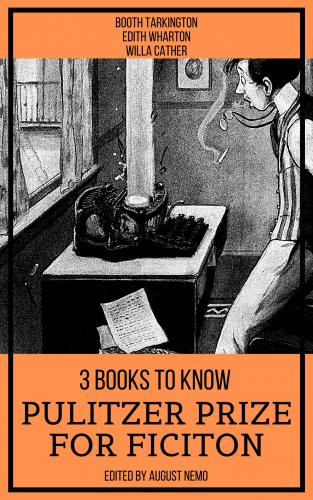Table of Contents
|
|
|
Introduction
Welcome to the 3 Books To Know series, our idea is to help readers learn about fascinating topics through three essential and relevant books.
These carefully selected works can be fiction, non-fiction, historical documents or even biographies.
We will always select for you three great works to instigate your mind, this time the topic is: Pulitzer Prize for Fiction.
The Magnificent Ambersons by Booth Tarkington.
The Age of Innocence by Edith Wharton.
One of Ours by Willa Cather.
This is one of many books in the series 3 Books To Know. If you liked this book, look for the other titles in the series, we are sure you will like some of the topics.
|
|
|
Authors
Newton Booth Tarkington (July 29, 1869 – May 19, 1946) was an American novelist and dramatist best known for his novels The Magnificent Ambersons and Alice Adams. He is one of only three novelists to win the Pulitzer Prize for Fiction more than once, along with William Faulkner and John Updike.
Edith Wharton was an American novelist, short story writer, playwright, and designer. Wharton drew upon her insider's knowledge of the upper class New York "aristocracy" to realistically portray the lives and morals of the Gilded Age. She was the first woman to win the Pulitzer Prize for Literature in 1921. She was inducted into the National Women's Hall of Fame in 1996.
Willa Sibert Cather was an American writer who achieved recognition for her novels of frontier life on the Great Plains. Cather graduated from the University of Nebraska–Lincoln. She lived and worked in Pittsburgh for ten years, supporting herself as a magazine editor and high school English teacher. At the age of 33 she moved to New York City, her primary home for the rest of her life, though she also traveled widely and spent considerable time at her summer residence on Grand Manan Island, New Brunswick.
|
|
|
The Magnificent Ambersons
by Booth Tarkington
Chapter I
Major Amberson had “made a fortune” in 1873, when other people were losing fortunes, and the magnificence of the Ambersons began then. Magnificence, like the size of a fortune, is always comparative, as even Magnificent Lorenzo may now perceive, if he has happened to haunt New York in 1916; and the Ambersons were magnificent in their day and place. Their splendour lasted throughout all the years that saw their Midland town spread and darken into a city, but reached its topmost during the period when every prosperous family with children kept a Newfoundland dog.
In that town, in those days, all the women who wore silk or velvet knew all the other women who wore silk or velvet, and when there was a new purchase of sealskin, sick people were got to windows to see it go by. Trotters were out, in the winter afternoons, racing light sleighs on National Avenue and Tennessee Street; everybody recognized both the trotters and the drivers; and again knew them as well on summer evenings, when slim buggies whizzed by in renewals of the snow-time rivalry. For that matter, everybody knew everybody else's family horse-and-carriage, could identify such a silhouette half a mile down the street, and thereby was sure who was going to market, or to a reception, or coming home from office or store to noon dinner or evening supper.
During the earlier years of this period, elegance of personal appearance was believed to rest more upon the texture of garments than upon their shaping. A silk dress needed no remodelling when it was a year or so old; it remained distinguished by merely remaining silk. Old men and governors wore broadcloth; “full dress” was broadcloth with “doeskin” trousers; and there were seen men of all ages to whom a hat meant only that rigid, tall silk thing known to impudence as a “stove-pipe.” In town and country these men would wear no other hat, and, without self-consciousness, they went rowing in such hats.
Shifting fashions of shape replaced aristocracy of texture: dressmakers, shoemakers, hatmakers, and tailors, increasing in cunning and in power, found means to make new clothes old. The long contagion of the “Derby” hat arrived: one season the crown of this hat would be a bucket; the next it would be a spoon. Every house still kept its bootjack, but high-topped boots gave way to shoes and “congress gaiters”; and these were played through fashions that shaped them now with toes like box-ends and now with toes like the prows of racing shells.
Trousers with a crease were considered plebeian; the crease proved that the garment had lain upon a shelf, and hence was “ready-made”; these betraying trousers were called “hand-me-downs,” in allusion to the shelf. In the early 'eighties, while bangs and bustles were having their way with women, that variation of dandy known as the “dude” was invented: he wore trousers as tight as stockings, dagger-pointed shoes, a spoon “Derby,” a single-breasted coat called a “Chesterfield,” with short
